|
FAQs on Characoids/Tetras & Relatives Disease/Health
4
FAQs on Characoid Disease:
Characoid Disease 1,
Characoid Disease 2,
Characoid Disease 3,
Tetra Disease 5, Tetra Disease 6,
FAQs on Characoid Disease by Category:
Diagnosis,
Environmental,
Nutritional,
Infectious,
Parasitic,
Social,
Treatments
Related Articles:
Characoids/Tetras & Relatives,
Related FAQs: Characoids/Tetras &
Relatives, Characoid
Identification, Characoid
Behavior, Characoid
Compatibility, Characoid
Selection, Characoid Systems,
Characoid Feeding,
Characoid Reproduction,
|
|
|
marks on Black Neon tetra 8/10/15
Dear WWM Masters,
<Howdy Dev!>
Thanks a ton for the incredible service you provide to let us take better care
of our charges. Much appreciated.
<Glad we can share>
The attached picture is of one of my shoal of 8 Black Neons. Any idea what the
markings might mean? Others do not have anything similar. They are 4 months in
the tank, no change in appetite or behaviour.
<Yikes.... Remove and isolate (or... destroy) the affected fish.... This appears
to be an incidence of "Neon Tetra Disease" (Pleistophora, a Microsporidean)...
yes, does infests other fishes.... Not curable (at this point)>
This 'warm water' tank is 30X15X12(H), about a year old, filtered by a 500l/hr
HOB packed with ceramic and bioballs and a similar flow internal power similarly
packed. NH3, NO2, NO3 0,0,<10; pH 7.3, kH 3, TDS 150, tankmates 6 Sterbai Cory,
4 each of Rummynose and Cardinal tetras, 1 male Pearl Gourami and a Red Lizard
Plec. Crypts, Anubias, Java Fern, floating
pennywort and duckweed, Indian Almond leaves, submerged roots, river stones,
caves, sand substrate. Temp is now above 30C from an Indian summer.
It has a laminar flow fan blowing across the surface, no artificial lights.
20% weekly water change, feeding from Hikari Micro pellets, sinking wafers,
Ocean Nutrition Brine Shrimp plus and Spirulina flakes and Tetra bits.
Freeze dried bloodworms occasionally. I dose K2SO4 as per EI and Seachem
Flourish Comprehensive and Iron.
Should I be concerned?
<Yes; and sorry to be the bearer of such bad news. DO search re the terms
above... this could be another Microsporidean, Protozoan, even some worms.... As
usual/always I (and I'd go far to say many other WWM Crew)
state simply what we would do given similar/same circumstances. NOT worth
waiting... isolate or euthanize this black Neon>
Thanks again.
Regards
Devakalpa (India)
<Welcome. Bob Fenner>
|
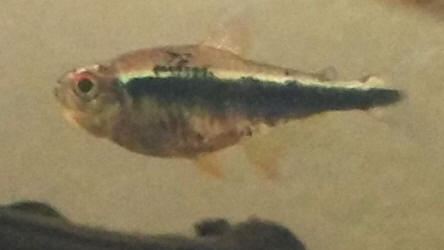 |
|
Re: marks on Black Neon tetra
8/11/15
Dear Bob,
<Dev>
Thanks for the inputs. I shall act accordingly.
<Ah, good. Please keep us informed; send along your observations. BobF>
Regards
Devakalpa
Re: marks on Black Neon tetra
8/17/15
Dear Bob,
<Dev>
Apologies for the delay in updating. I went the clove oil route the day I heard
from you, it seemed to be the safest (but tough) option.
<Yes>
Since then no signs of contamination yet; the remaining Black Neons, Cardinals
and Rummy Noses are doing fine.
<Glad to read>
Thanks again
Devakalpa
<Welcome. Bob Fenner>
|
|
Tetras with white mouths (and a bit about rosy barbs)
3/19/15
Hi Crew,
I'd like to thank you once more for your previous advice, last time I wrote
about a suspected case of Ich which is now resolved. I've had no more fish
deaths since losing the last of the extra rosy barbs that I bought from the LFS,
sadly Pinkie succumbed to his saddle ulcer in the end. I had him quarantined for
the last week or so of his time, and whatever he had does not seem to have
affected the rest of my fish. I still see the occasional white or clear stringy
droppings from the rosy barbs but I am starting to suspect this is a result of
them accidentally ingesting sand then excreting it in mucus as there are plenty
of green and brown droppings too and they all seem healthy otherwise.
<Mmmm; what re water quality, foods/feeding, maintenance practices?>
Currently my 30gal tank has one head and tail light tetra, three adult
rosy barbs, and all 16 of the barb offspring (ranging from 1cm to 2.5cm).
I'm aware that this will be far too many rosy barbs when they grow up
so I'm hoping to find a home for them in the big aquarium at work which
currently only has a single small fancy (ugly) goldfish.
<Should be moved elsewhere>
I'm not sure that this will be a compatible mix though since even if 5+ barbs
are added to keep them well behaved and not nippy, I think they might dominate
at feeding time due to being more able-bodied and they might starve out the
goldfish. Thoughts?
<All should get along w/ the GF removed>
The other option I have in mind is to set up better filtering in the backyard
pond and to put some back out there. A lone
stray barb fry survived 2 weeks out there during the hottest part of summer, he
was too good at hiding and got left behind when I brought the others that had
hatched out there inside, so I think the pond does get enough shade to
keep the temperature down. Winters here are mild too.
<Good... barbs might live there; but not the Tetras likely in the winter>
With the threat of ich and Columnaris gone I have bought four more head and tail
light tetras to keep my singleton Mr. Beacon company.
<Good name>
I've been trialing different plants in the main tank and do intend to keep it
heavily planted (despite the best efforts of the barbs to eat/uproot everything,
I've been finding this constant battle part of the fun of keeping fish) so I am
hoping the HATL tetras will be happy in the environment. The LFS does not stock
these tetras so I bought them online and besides, I hoped to
avoid a known source of diseased fish. When they got here, two of them had white
coloured patches on their mouths, and one of them was very sickly, limp and
skinny looking.
<I see this in your excellent pix>
My initial thoughts were that they may have scuffed their mouths against the
plastic bag in transit, or gotten feisty with each other since they were all
together in the one small bag, and gotten injured while fighting. The bag wasn't
a breather bag and the skinny fish did perk up once out of the bag and in
quarantine, he hides a bit but his appetite seems okay and his belly is filling
out a bit more; he could have been underfed or oxygen starved maybe but I'm a
little suspicious that he could have fish TB or some other disease that could
cause skinniness. I've treated them with Praziquantel so far just in case they
were skinny due to worms.
<Mmm; possibly>
I'm using the tank that the baby fish used to be in, the tetras have been in
quarantine for a week now and I think that in two of them the white mark has
gotten smaller but noticed today that a third one has a white mouth too. I'm a
little worried it could be Columnaris not a wound, or a wound that got infected
with Columnaris.
<Maybe>
I've attached some pictures, and also a picture of one of the friends I got for
the false penguin tetra (they have their own tank now due to being too rough!)
who has a similar mark. I don't know if it is just that these tetras fight or
swim into things a lot; the quarantine tank that the four HATL tetras are in is
too small and I know they aren't happy with the amount of space they have. I'm
wary of treating with anything beyond a little bit of salt for now
<Good>
and I'm just hoping after another week or two in quarantine nothing will have
worsened and I can get them into the bigger tank. Anyway I just don't have the
experience to tell whether these white mouthed fish are injured or diseased or
both. Hope you can help.
<Not w/ the data (or lack of it) provided>
I did end up getting a RO/filter system which has a mixer tap and a TDS inline
meter allowing adjustment for both drinking water and aquarium water. I still
don't quite have my head around converting TDS ppm to general hardness degrees -
I did read somewhere that dividing ppm by 10 will loosely approximate French
degrees but then I don't know whether French or German degrees are more commonly
used.
<German... the D in these measures is for "Deutschen">
I haven't had any further shrimp deaths due to failed moults since I've started
using 50-70ppm water for my shrimp tank so it's definitely helping. I'm
wondering whether I should still be letting my RO-mix change water stand
before I use it;
<Yes I would... at least a day; better, a week>
I haven't been, because I thought that it was only necessary to allow time for
water treatment chemicals to do their work but is letting water stand useful for
other reasons?
<Mmm; yes.... settling, combination.... of metals, non-metals... outgassing of
undesirable gasses>
I have a 20lt plastic jerry can which I store the water in, this doesn't allow
much exposure to atmosphere so should this
water be agitated? Or just tipped into buckets?
<Tipped is fine, aeration/circulation better>
Ok sorry this got to be a lot longer than I originally intended! I really
appreciate the time you take with educating new hobbyists like me and reading
our rambling emails.
<We appreciate the opportunity to interchange w/ intelligent, sensitive folk
like you>
I've still got a lot of reading that I want to do regarding Corydoras as I have
decided I'd like a biotope tank rather
than putting them in the community and making them compete with greedy barbs,
and I think it would be easier to manage water softness and ph if I start again
and do things differently in a new tank.
Thanks once again and I hope you have a great day.
Bronwen
<Welcome. Bob Fenner> |
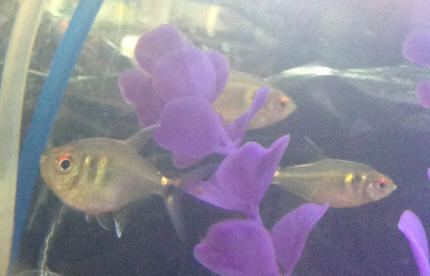
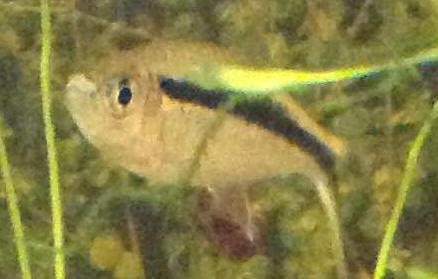 |
|
Re: Tetras with white mouths (and a bit about rosy barbs)
3/20/15 /Neale
With regards to the barbs occasional odd dropping, they are fed once daily or
twice if I don't have time to watch them in the morning. If I am in a hurry they
get a quick pinch of flake and then I take a bit more time in the evening feed
to watch how much they are eating.
<Fine. Barbs are omnivores that will eat algae, some plant matter between
"proper" meals.>
I have some frozen community blocks which contain both meaty and plant
materials, I usually give this two to three times a week (slicing off a small
amount and feeding little by little trying to avoid over feeding). I have some
Spirulina sinking pellets (also contains other ingredients) that I bought for
the shrimp but proved to be very popular with the barbs, they will carry the
pellets around spitting them out and sucking them up again, gradually working on
them until they soften up.
<Quite so, and an excellent staple for your fish... good nutrition, plenty of
exercise, economical. My Cherry Barbs are fed these alongside the Limia they
cohabit with.>
I crush some up for the younger fish but they seem to manage okay on full sized
pellets, worrying at them until they break into smaller bits. I have some
meatier pellets, with a higher protein content but they are not as popular so I
don't feed those very often.
<Indeed. These fish are omnivores, and plant material is a significant part of
the diet of most/all barbs in the wild.>
They get smushed up frozen peas, thawed and peeled, every few days which they
love. If I find a patch of snail eggs I will knock it off the glass and the
female adult barb in particular loves munching on those.
Occasionally I net some mosquito larva from either the pond or the snail tub and
these make a popular snack.
<Sure.>
I believe they have eaten some of the Ramshorn snails that were in their tank,
there are a growing number of empty shells visible on the bottom, and they
definitely rip at the Java moss, Hydrilla, Rotala, and Hydrocotyle plants
constantly. I'm pretty sure they ate 90% of the fissidens moss I added too, and
almost all of the hair grass is gone too now that I think
about it. I was worried at first that they were doing this because I wasn't
feeding them enough but they were still doing it when I tried feeding them twice
a day which I decided was too much. I think if they like eating fresh plants
then they should be allowed to eat fresh plants so I've been growing more
Hydrilla in a tank outside for them since that's the one they stripped
to bare stems first of all.
<Indeed. Try floating Indian Fern and Amazon Frogbit, two favourites with many
barbs.>
I don't often see the tetra eat, he hangs back while the barbs feed so I always
attempt to get a pinch of flake to his part of the tank. He doesn't like me
scrutinising him though and moves front on so that he's hard to see. He does get
interested in the frozen food and will test and spit out various particles of it
until he finds one that he likes, I'm hoping he gets a bit more confidence once
his fellow tetras join him, I've been feeding them a small amount of flake daily
and they get quite excited at
feeding time so I think in a group his instincts will kick in if he sees a lot
of feeding action going on around him.
<Tetras are frequently more carnivorous, especially the smaller ones Neons,
Penguins, various Hyphessobrycon species and so on. They often enjoy Daphnia and
the like. On the other hand, do bear in mind some tetras are much more retiring
than Barbs. Put another way, many South American tetras come from blackwater
streams with very little productivity. They've evolved to expend as little
energy as possible between meals. Barbs typically come from ponds and streams
with much more productivity and a lot more for them to eat. They've evolved to
be more "busy" and expend their energy in all sorts of foraging and social
behaviours. In other words, tetras wait for food to come to them, while barbs
seek it out and if necessary push competitors away. Funnily enough, those barbs
from blackwater streams (like Pentazona Barbs) are much more like Neons and
other tetras in personality.
In any event, if you understand the environment the barb or tetra species come
from, cohabiting different species from among them will work better.
Tiger Barbs are bolshy, so mixing with pushy characins like Black Widows makes
sense. Rosy Barbs are subtropical to boot, so you'd choose only low-end tropical
tetras for life with them, perhaps Buenos Aires Tetras.
Does this make sense?>
I haven't measured my water parameters for a while but for a long time I was
getting pH steady at 8 (despite driftwood and almond leafs) ammonia 0, nitrite 0
and nitrate 5-10. I do weekly water changes and fortnightly rinses of the gunk
from the filter. I try weekly to vacuum the gravel in the gravelly parts of the
tank and skim the surface of the sand in the sandy parts of the tank but I don't
know how effective a job I do. I always see gunk being sucked up the tube but
everything looks even messier than when I started once I've tipped the new water
in.
<Sounds good. Cheers, Neale.>
Tetras with white mouths (and a bit about rosy barbs)
/Neale 3/21/15
Hi Crew,
I'd like to thank you once more for your previous advice, last time I wrote
about a suspected case of Ich which is now resolved. I've had no more fish
deaths since losing the last of the extra rosy barbs that I bought from the LFS,
sadly Pinkie succumbed to his saddle ulcer in the end. I had him quarantined for
the last week or so of his time, and whatever he had does not seem to have
affected the rest of my fish. I still see the occasional white or clear stringy
droppings from the rosy barbs but I am starting to suspect this is a result of
them accidentally ingesting sand then excreting it in mucus as there are plenty
of green and brown droppings too and they all seem healthy otherwise.
<Smooth silica sand should be fine... but anything abrasive or sharp, like some
of the glass-byproduct sands (Tahitian Moon Sand for example) could be risky.>
Currently my 30gal tank has one head and tail light tetra, three adult rosy
barbs, and all 16 of the barb offspring (ranging from 1cm to 2.5cm). I'm aware
that this will be far too many rosy barbs when they grow up so I'm hoping to
find a home for them in the big aquarium at work which currently only has a
single small fancy (ugly) goldfish. I'm not sure that this will
be a compatible mix though since even if 5+ barbs are added to keep them well
behaved and not nippy, I think they might dominate at feeding time due to being
more able-bodied and they might starve out the goldfish. Thoughts?
<It can work, in big tanks with robust Comet-type Goldfish and decent sized
schools of Rosy Barbs. But fancy Goldfish are less able to keep out of trouble.
It really isn't predictable. Worth trying but keep a Plan B in case it doesn't
work out.>
The other option I have in mind is to set up better filtering in the backyard
pond and to put some back out there. A lone stray barb fry survived 2 weeks out
there during the hottest part of summer, he was too good at hiding and got left
behind when I brought the others that had hatched out there inside, so I think
the pond does get enough shade to keep the temperature down. Winters here are
mild too.
<Rosy Barbs are subtropical and could thrive down to about 15 C, but below that
would be risky.>
With the threat of ich and Columnaris gone I have bought four more head and tail
light tetras to keep my singleton Mr. Beacon company. I've been trialing
different plants in the main tank and do intend to keep it heavily planted
(despite the best efforts of the barbs to eat/uproot everything, I've been
finding this constant battle part of the fun of keeping fish) so I am hoping the
HATL tetras will be happy in the environment. The LFS does not stock these
tetras so I bought them online
and besides, I hoped to avoid a known source of diseased fish. When they got
here, two of them had white coloured patches on their mouths, and one of them
was very sickly, limp and skinny looking. My initial thoughts were that they may
have scuffed their mouths against the plastic bag in transit, or gotten feisty
with each other since they were all together in the one
small bag, and gotten injured while fighting. The bag wasn't a breather bag and
the skinny fish did perk up once out of the bag and in quarantine, he hides a
bit but his appetite seems okay and his belly is filling out a bit more; he
could have been underfed or oxygen starved maybe but I'm a little suspicious
that he could have fish TB or some other disease that could
cause skinniness. I've treated them with Praziquantel so far just in case they
were skinny due to worms.
<Fish TB is difficult to diagnose and impossible to treat. It's less contagious
and more like an epidemic that breaks out when fish get stressed (diet, poor
water quality, lack of oxygen, etc.). So I tend not to worry about Fish TB but
instead focus on optimising living conditions for the fish. Usually "mystery
deaths" either sort themselves out or else all the vulnerable fish die. Adding
medications randomly is a bit hit and miss, and while PraziPro isn't
particularly risky, do be careful about medicating
without diagnosis.>
I'm using the tank that the baby fish used to be in, the tetras have been in
quarantine for a week now and I think that in two of them the white mark has
gotten smaller but noticed today that a third one has a white mouth too. I'm a
little worried it could be Columnaris not a wound, or a wound that got infected
with Columnaris. I've attached some pictures, and also a picture of one of the
friends I got for the false penguin tetra (they have their own tank now due to
being too rough!) who has a similar mark. I don't know if it is just that these
tetras fight or swim into things a lot; the quarantine tank that the four HATL
tetras are in is too small and I know they aren't happy with the amount of space
they have. I'm wary of treating
with anything beyond a little bit of salt for now and I'm just hoping after
another week or two in quarantine nothing will have worsened and I can get them
into the bigger tank. Anyway I just don't have the experience to tell whether
these white mouthed fish are injured or diseased or both. Hope you can help.
<Well, the photos look more like fighting damage, perhaps a bit of Finrot or
Columnaris thrown in. Another option: swimming into solid objects (like the
glass) when alarmed. So for this one turn the lights on more carefully and see
what happens. So far as fighting goes, watch your fish, add more of each species
to dilute aggression (if an option) and medicate as per Finrot
and Columnaris.>
I did end up getting a RO/filter system which has a mixer tap and a TDS inline
meter allowing adjustment for both drinking water and aquarium water. I still
don't quite have my head around converting TDS ppm to general hardness degrees -
I did read somewhere that dividing ppm by 10 will loosely approximate French
degrees but then I don't know whether French or German degrees are more commonly
used. I haven't had any further shrimp deaths due to failed moults since I've
started using 50-70ppm water for my shrimp tank so it's definitely helping. I'm
wondering whether I should still be letting my RO-mix change water stand before
I use it; I haven't been, because I thought that it was only necessary to allow
time for water treatment chemicals to do their work but is letting water stand
useful for other reasons? I have a 20lt plastic jerry can which I store the
water in, this doesn't allow much exposure to atmosphere so should this water be
agitated? Or just tipped into buckets?
<Bob's a big fan of overnight "resting" of water, ideally with an airstone, but
not essential. I'm less fussed, and just avoid changing huge amounts of water.
Basically, if you just change 20-25% of the water at a time, and use a water
conditioner, you shouldn't need to worry too much about resting the tap water.
Freshwater fish are very much more adaptable than marine fish. Think about rain
falling into a pond.>
Ok sorry this got to be a lot longer than I originally intended! I really
appreciate the time you take with educating new hobbyists like me and reading
our rambling emails. I've still got a lot of reading that I want to do regarding
Corydoras as I have decided I'd like a biotope tank rather than putting them in
the community and making them compete with greedy
barbs, and I think it would be easier to manage water softness and ph if I start
again and do things differently in a new tank.
<Possibly. I'm a big fan of sticking with the water chemistry you have, and
choosing your fish accordingly. That said, a 50/50 mix of RO water and liquid
rock tap water should produce a happy medium that suits most community fish.>
Thanks once again and I hope you have a great day.
Bronwen
<Most welcome. Neale.>
Tetras with white mouths (and a bit about rosy barbs)
3/21/15
Hi again Crew!
Thank you for your replies Bob and Neale. My heart says that I should move the
head and tail light tetras into the main tank to give them space and stop them
from squabbling or bumping into things, but my head says to give them another
week of quarantine to see how their mouth lesions develop.
<Agreed.>
I slept on this idea and this morning while one HATL tetra is still without
mouth issues, two of the other three look worse and the white patches seem to be
protruding more than they were yesterday. Although, having said that, I did use
a brighter light so that I could see them better, maybe the lesions were like
that all along and I just didn't see - normally they have half the tank in shade
c/o a black plastic garbage bag and the other half lit by a strip of dim LEDs. I
don't really think the lesions look fluffy, more so a bit ragged like the edge
of some peeled skin in places, and warty in others. However this fluff free
finding doesn't relax me at all, as Pinky's back ulcer was never fluffy either
and that evolved from a small lesion to a large fatal ulcer over the
Christmas/New Year break (I didn't have anything available except topical
treatments until it was too late). I
don't really want to give infection a chance to set in again, but I am mindful
also that these are different fish, from a different supplier, in a different
tank, with different looking lesions that are in a different location on the
fish, so I shouldn't expect a similar outcome to last time!
I want to wait a bit longer and observe them tomorrow with the same bright light
so that I can get a real idea if there is any progression. I do have
tetracycline (Bio-tet) or Metronidazole (generic looking yellow tablets)
available now for if the lesions worsen, although I'm not sure if I want to
treat all the fish, or only the ones that are showing visible lesions.
<I do think these mouth lesions are either plain vanilla dead tissue from
fighting or crashes into solid objects, or else incipient Columnaris.
Either way, treat with a suitable antibiotic, while also review conditions in
the tank.>
An observation on a different front, I would be hard pressed right now to pick
out which of these fish was the skinny sickly one from a week ago. All of them
have good colour and healthy looking bellies now. I am really looking forward to
seeing them school together in the big tank once they are done in quarantine! I
have discovered that my dad's compost heap has
Whiteworms in it as well as the big pink compost worms so I want to set up a new
clean worm culture for some tasty occasional snacks for the fish, which I hope
the tetras will like.
<Sounds a great idea.>
Speaking of which, the other fish haven't been eating my Ramshorn snails at all!
I found three snails fatally jammed in the filter inlet grille today.
I am guessing as the grille becomes more clogged with plant matter it becomes a
tempting place to graze for the snails but the increased suction as they clear a
blockage pulls them in to the inlet pipe and traps them there, where they die
since their shells can't follow. I have seen snails "hanging around" the inlet
pipe before but didn't realise this was happening. The filter pipe has probably
been slurping snails out of their shells all along as the barbs seem content to
bite their eyestalks off then
go back to ripping at the plants. I've adjusted the sponge that I put over the
grille so that only the most suicidal snails will be able to force their way in
there, and I will just have to remember to rinse the debris out more often.
<Hmm... some folks would endorse a filter with snail-killing properties...>
I've decided that it will probably be more humane to leave the fancy goldfish in
peace in the aquarium at work and to get a nice pond filter going to allow
rehoming the excess rosy barbs outside, I probably wouldn't be able to provide
adequate supervision to stop any possible mayhem that could occur with the work
goldfish. It does get a smidge under 15 deg C here over winter, but the pond
should get winter sun.
<Definitely worth trying, I reckon.>
If I can't work something out using either a solar pond cover or something
similar to harness solar warmth, I can always bring everyone back inside in a
temporary plastic crate for the coldest months.
<Both approaches make sense. Cutting down wind chill in winter with, say, a
bamboo cover of some sort might work nicely. On the other hand, bringing in some
or all of the Rosy Barbs before the coldest months start can work great, too.
Have known many aquarists do this, even in places like Ohio where the summers
are nice and hot but the winters rather severe. They had fish that bred
prolifically during the summer, but snuggled up indoors for the winter. It's an
ideal approach if you're careful, and I found Corydoras for example easily bred
this way.>
Thanks again for helping me sort through these problems!
Cheers,
Bronwen
<Cheers, Neale.>
Re: Tetras with white mouths (and a bit about rosy barbs)
3/29/15
Hi Crew! I hope all is going well with you.
<Certainly is.>
A quick update on the tetras: the mouth lesions shrank away to nothing on two of
the head and tail light tetras while the remaining one is almost gone.
<Good to hear.>
It's starting to get cooler overnight here so I decided it was time to transfer
the new ones to the main tank as the quarantine tank doesn't have a heater yet -
prior to now the water temp has rarely been under 26 C. The new tetras settled
in straight away and Mr. Beacon joined up with the group as soon as he noticed
them. As far as I can tell from both the size
differences and the swim bladder shapes, Mr. Beacon is in fact correctly named
and is male with a pointy swim bladder, while the new tetras are a little
larger, a little more lightly coloured, with bluntly rounded swim bladders, and
all female. The largest two females seem to push each other around a bit and
vary between ignoring Mr. Beacon, and chasing him away. He
seems to spend a quarter of the time hiding, a quarter of the time trying to
sidle up to a female while she ignores him and swims away, and the rest of the
time they hang together in a loose school with no hassles.
<Interesting.>
Perhaps without another male to compete against, the females find him completely
unimpressive?
<Or they're sexually immature, or a different lookalike species.>
In any case it's a big improvement for him activity wise, and i am pretty sure
he is a bit bolder at meal times. The tetras seem to love the Spirulina pellets
just as much as the barbs do, and grab one and hold it in their mouths until it
softens up so that no one can steal it from them. They occasionally pop the
pellet out and balance it in their lips before quickly sucking it back in, which
looks really cheeky, but I am guessing they are just checking it for softness.
<Fish can't chew.
<<Mmm; many can. RMF>>
If they need to break food down, they often crunch it as best they can, spit it
out, suck it back in, and repeat as necessary. Since water buoys up food
particles for a while, keeping them close to their mouths, this isn't too
inefficient.>
I'm glad you talked me out of taking any drastic measures with regards to
treating the mouth lesions, it's hard to stay patient when the Internet is full
of horror stories of apparently healthy fish who turn into sideways floating
piles of white fuzz overnight, etc, but "wait and see" did produce the best
result, allowing the fish to fix themselves.
<Pretty much.>
We had a near miss in the work aquarium, jammed/busted impeller in the filter
pump turned it into a heater. I noticed the filter wasn't running right at the
end of the day and the water was warm enough to bath in! Must have been cooler
towards the bottom of the tank otherwise I don't know how the poor goldfish
didn't cook. I don't think he would have made it if it
was left like that overnight. Well it turned out for the best for the goldfish,
the replacement filter doesn't have anywhere near as strong a flow rate so he
doesn't get blasted around the tank any more like he used to, but it goes to
show the tank isn't in a position where it gets seen often enough for people to
catch any problems. I only saw it because I was being particularly lazy and
looking for ways to waste time, under normal circumstances it wouldn't have been
seen until the next day. So I am now
even more convinced not to take any rosy barbs to go in that tank. The office
area is going to be overhauled soon so if the new layout involves the fish tank
being in a better place I might change my mind.
<Quite so; sounds like a good project to think about some time. Generally yes,
the best place for a fish tank is a reasonably busy place where people can see
the tank and be mindful of its care, plus somewhere it's easy enough to get
buckets of water to and from. Direct light and heavy footfall aren't helpful
though.>
Thanks again!
Bronwen
<Good luck, Neale.>
fish + chewing 3/30/15
> Hi Bobster!
<Hey Neale>
> Chewing is, zoologically speaking, confined to mammals. You need molars and
cheeks to do it, plus the right sort of muscles, nerves and enzymes.
<Mmm; let me see re a ref. here: I see that they don't!
"Do fish chew their food? Fish do not chew their food in the same manner we do.
Many carnivorous fishes (meat eating) use their sharp teeth to capture and hold
prey while swallowing it whole or in large pieces. We use teeth to grind food
into tiny pieces, and then we swallow. Bottom dwellers such as rays have large
flat teeth that crush the shellfish they eat. A number of herbivorous fishes
(grazers) grind their food in a manner similar to humans. However, the
tooth-like grinding mills are located in the throat rather than in the mouth,
and are referred to as pharyngeal ("phar-yn-geal") teeth. ">
> What a few fish do is grind (see for example coral-eating parrotfish). So far
as I know, they don’t have the tongue and cheek muscles needed to position and
reposition the food inside the mouth while they’re doing it. They certainly
don’t moisten the food (hardly necessary!) and neither do they apply enzymes
produced by the mouth to start digestion. Subsequent processing happens in the
throat of course, with the pharyngeal teeth. But that isn’t chewing either.
> Cheers, Neale
<A matter of definition on my part. Cheers, BobF>
Re: fish + chewing 3/30/15
Quite so. But neither you nor I would call ourselves zoologists if we didn’t
have a tendency towards pedantry now and again!
<A trend I try to be aware of and resist>
So, the podcast was pretty fun. Mentioned WWM a few times, but I’m sure an “all
Bob, all the time” episode would be better!
<Am very sure this is not the case>
Cheers, Neale
<And you; BobF> |
Minor Serpae Tetra fin rot? 11/2/14
Greetings. I have a 55-gallon aquarium that we set up 2 years ago & has
been stable and disease-free. Water parameters are: ammonia = 0, nitrite
= 0, nitrate = 30, phosphorous = 0. I do a water change every week. We
have live plants (water sprite wisteria). The inhabitants are 2
Bristlenose Plecos, 8 black-skirt tetras, 8 white-skirt tetras, 11 minor
Serpae tetras, and about 6 apple snails. The Serpae tetras were
introduced about 2 weeks ago and my quarantine tank currently is housing
some baby Gold Gouramis, so
I chose not to quarantine them. I know I should have, but I have never
had any problem with the tetras from this source. A bad decision on my
part, but anyway, may I explain the problem to you...?
<Fire away.>
Oddly enough, the other fish in the tank seem to be still healthy and
unaffected by this disease bothering the serape tetras. It is the
strangest thing I have ever seen. The first sign is a very pale area
where the dorsal
fin meets their body. It's very clearly delineated and easy to see
against their red-orange background. Soon after that, the dorsal fin
degenerates and the fish seems to die within a day or two after they
reach that stage.
They don't seem swollen and neither do they show any other signs of
illness. I have never seen fin rot behave like this or fin rot that just
affects one species of tetra. Today, I got some API Triple Sulfa and am
planning on giving them the entire course of treatment as directed by
the manufacturer. Do you think that I am on the right track here? Please
advise and thank you so much for your time and any comments you may have
for me.
<Serpae Tetras are notorious fin-nippers, so one explanation is that
they're fighting within the group (which they do, especially when
feeding) and damaging one another. When feeding they have a feeding
frenzy
behaviour, but will also bully weaker specimens, even killing them.
Usually they attack other fish too, but the Black/White Skirt Tetras
(both Gymnocorymbus ternetzi) are pretty pushy, fast-moving little fish
themselves, and may be holding their own just fine. Gouramis, though,
are easy targets so I wouldn't mix them. This said, it is rare for
Finrot to kill fish within a couple days. Adding more Serpae tetras
might help, by
spreading out any aggression, but before doing that you'd want to
observe the Serpae Tetras and see if they're chasing or nipping each
other. If they are fighting, adding a few more could be a good move.
Alternatively, you might simply have a "bad batch" of Serpae Tetras, in
which case medicating for Finrot might stabilise things, giving you time
to see if they can be saved. If the fish get better, then no harm done.
If they eventually all die, I'd recommend not buying Serpae Tetras
again. Although cheap and usually extremely hardy, they aren't well
behaved fish, and there are better alternatives such as Red Phantom
Tetras out there.>
Riobhcah
<Cheers, Neale.>
Re: Minor Serpae Tetra fin rot? 11/15/14
Greetings. Well, I treated the entire aquarium with API Triple Sulfa for
four days and then observed the aquarium for several days and the
mysterious problem of the bacterial infection with the Serpae Tetras
seems to have been eradicated. All the fish look very healthy.
<Good.>
I have been watching them closely for fin nipping and have only seen a
limited amount of chasing amongst the Serpaes and a few isolated
incidents of them bothering the black & white skirt tetras who, as you
previously
stated, can give it back to them even better than the Serpaes can dish
it out.
<Often the case. Both species are "fin nippers" but Serpae Tetras tend
to be more persistent and vicious, whereas Black Widows generally behave
themselves if there's enough of them.>
I haven't seen them bothering the gold gouramis, who can be rather
pugnacious also if they choose to do so.
<Males, yes; females less so, if at all. Also, as they age, they slow
down a lot, making them easier targets, so do keep an eye out for them.>
I will watch the gouramis closely and move them to another aquarium if
necessary. I will keep watching the Serpaes for aggression. I have not
found anyone yet who has any idea exactly what this strange infection
was,
but the guy at PetSmart said that the others that came in in that
particular group had to be treated with antibiotics as well. Anyway,
just to let you know what the outcome was with this incident. Thanks for
the heads-up on Serpae aggression. I did notice that they are on nippy
fish.net where they seem to be known as the culprit in many a
fin-nipping incident.
<Indeed. Excellent fish in terms of colour, size, and usually hardiness.
They were extremely common fish in the aquarium hobby during its earlier
phase. But nowadays are not as popular. Unfortunately some retailers
give them alternate names, making it easy to buy them by mistake. Red
Minor Tetra, Jewel Tetra, Hyphessobrycon eques, Hyphessobrycon calistus
and Hyphessobrycon serpae are some of the names you'll see.>
Thanks again for your advice.
Rivqah
<Welcome. Neale.>
|
Payara help - parasites
2/3/13
Hi Crew, How are you?
<Fine; but you've surpassed (way) our limit for file size>
My name is Daniel and I'm facing a strange problem with my characins fishes.
It seems like a parasite problem but I'm not sure of which kind.
The symptoms are: 1- Little white spots in fins and eyes. 2- Eyes
sometimes clouded but not the entire eye! Just a portion of the cornea.
3-Some thin "things" like a baby's hair attached to the fish.
My fishes are eating well. They aren't rubbing against nothing. All symptoms
seems to be cyclic and the cycle seems to be fast (days to weeks).
I took that pics from the eye of my H. tatauaia yesterday, today that eye is
almost completely normal...but the other one turned cloudy today.
<Mmmm... something going on here. IF only one fish, perhaps just a physical
trauma>
Pics attached.
*Note that besides the "large eye spot" there is some small too.
*Note the "thin hair thing" in the back of the A. falcirostris.
<Have magnified... is this a crustacean parasite? Is it some sort of
artifactual material?>
My water parameters: no ammonia, nitrates..
<I take it you mean nitrites (with an 'i'). What are your nitrates?>
I really don't know, temp 28-29 Celsius, Ph 6.0, WC every
week, they eat frozen fish (entire fish not just fillet).
What is this? How can I treat?
<Can't tell from the data provided... I wouldn't "treat" at all; but
advance the maintenance (water and media change outs)... and stay observant>
Thank you and sorry for my bad English.
<No worries; I understand you and that/this is all that is important. Bob
Fenner>
Daniel
|
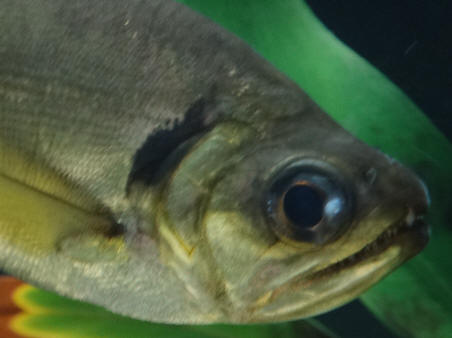
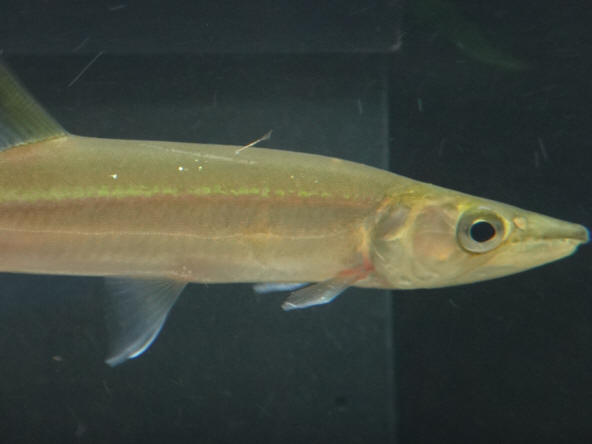
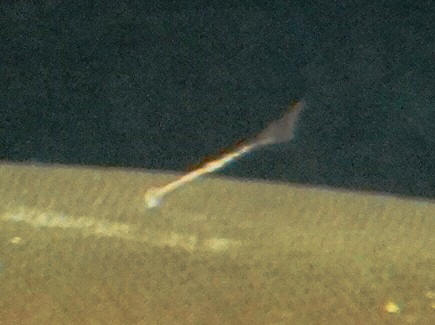
Looks like an embedded fin spine to me. |
Re: Payara help - parasites
2/3/13
Hi Bob, thank you for your reply!
I don´t have any trace of nitrites right now.
<Good... and the NitrAte? [NO3]?>
The problem is happening in at least 5 of my fishes. It seems to be
very cyclic. In 48 hours patches appear in the eyes of the fishes.
<Most likely environmental then; not pathogenic>
First they appear as cloud eyes and after sometime they turn white
"concentrated". After a day you can see very "thin things" (thinner than a
hair) leaving the eyes or fins of the fishes and the eyes became clear for 2
or 3 days and when you think that everything is ok, it happens again. It is
absolutely weird.
The Payara picture represents the concentrated phase (white).
I will resend you a picture with less pixels.
Thank you
D.
<The usual massive, consecutive days water changes; use of activated carbon,
PolyFilter or equivalent. BobF>
Re: Payara help - parasites
2/3/13
I'll check my nitrates tomorrow, my test is "out of date". Normally I do 50%
WC every 7 days. I 'll follow your advice and do it more frequently.
<I encourage you to add a few tablespoons of baking soda (Sodium
bicarbonate) each change as well... to aid nitrification, add a bit of
alkaline reserve. See Neale's article on same on WWM>
By the way, I'm running this system (140 gallon tank) with PolyFilter,
carbon and 40 liters of Siporax
<Ah yes; the Siporax might well remove most all NO3>
My fauna: 1. Hydrolycus tatauaia, 3 Acestrorhynchus falcirostris, 3
Boulengerella maculata, 1 Crenicichla tapajos II and 1 Potamotrygon hystrix
Thank you again Bob!
D.
<Welcome. B> |
|
Sick Tetras? 8/27/13
Hi guys,
<Chelsea,>
Starting out with details and parameters: I have a 30 gallon tank
that I set up almost three months ago. A month and a half a go, I
got 3 Neon Tetras and a Ghost Shrimp. Two of the Tetras died very
shortly, so I waited two weeks, checking parameters, and then got two
more Tetras. They have been fine until about four days ago.
<I see. Well, the quality of most farmed Neons is not good, and "Neon
Tetra Disease" (or diseases plural, there's some debate on this) can be
particularly difficult to deal with. Once sick from this disease, Neons
are highly contagious but difficult (usually impossible) to treat. That
said, not all Neons die from Neon Tetra Disease, so be open minded, and
do all the usual things you do when fish get sick, in case there's
another reason they're ailing.>
My Nitrates and Nitrites are at 0, but my ammonia is at .25ppm. My tap
water reads for over 1ppm straight out of the tap, so I have been using
Prime and I get false readings for my ammonia concentrates.
<Possibly, but be open minded and review filter capacity, feeding,
stocking, etc.>
I did a 25% water change two days ago, and before that, the ammonia read
at 0ppm.
<Good.>
I am having trouble identifying a disease that my Tetras seem to have.
It started out with one Tetra hiding instead of schooling with the
others.
<Is what Neons do when stressed, though is often associated with "Neon
Tetra Disease". Such fish should be promptly removed, and to be honest,
euthanised (I recommend the Clove Oil method as cheap, easy and humane).
You see, Neon Tetra Disease is extremely contagious, and medicating
isn't possible. If you suspect there may be another explanation, you
could isolate the Neon in a hospital tank and treat for Whitespot,
Finrot or whatever, but unless you're 100% sure that your fish doesn't
have Neon Tetra Disease, I'd always medicate in a hospital tank, not in
the display tank.>
When he came out of hiding to eat, I noticed a white spot on his lip.
I got some Jungle "Ick Guard" and have been using it per the directions,
as well as adding aquarium salt to my tank. Over the next day or
so, the sick fish got worse and the two others began to come down with
the same symptoms. I have been using the Ick Guard for 4 days now,
and the fish are
not getting better.
<Oh dear.>
Today, I noticed that my Ghost Shrimp had white spots on him, as well
(he disappeared for 3 days and I almost thought he was dead). I
Googled to see if invertebrates can get fish parasites, and the general
consensus was that they cannot.
<Correct, but many fish medications are lethal to shrimps, particularly
anti-Whitespot and similar medications that contain either copper or
formalin. Always remove shrimps when medicating, or else remove the sick
fish to a hospital tank.>
(Btw, he molted about a week ago, and one site said spots could be a
sign of molting - would he do it again so quickly?)
<May well do.>
Between the shrimp getting spots and my fish getting worse instead of
better, could the disease not actually be Ich?
<The photos are too blurry to be sure, but the fish look to me like they
might have either Finrot or Whitespot/Ick, it's just not clear to me.
Whitespot looks like the fish fins and body have had salt grains stuck
to them. It's very distinctive. Finrot erodes the fins usually from
their edges inwards, and the fins often go cloudy, sometimes pinkish, as
the fin membranes die. Again, quite easy to identify. It's possible for
a fish to have both, by the way, and they're both common problems in
newish tanks
when un-quarantined fish have been recently added and/or existing fish
exposed to poor water quality.>
Is there another disease that they might have, or is it just a
coincidence that the shrimp also has white spots?
<The latter; shrimps can't get Whitespot. For sure they might suffer in
some way from poor water quality, but Finrot as such isn't going to
happen.
Shrimps usually just die when stressed.>
I have included pictures, but they aren't terribly great because
everyone in the aquarium moves so fast.
<Quite so. Try using a net to gently hold a fish against the glass. Use
a tripod (or a friend with steady hands) to hold the camera.>
In the pictures, I have tried to point out spots where you might be able
to see the white spots. Thanks in advance for any help, you guys are an
amazing source of knowledge, and I have learned so much from your site.
Chelsea
<Hope this helps, Neale.>
|
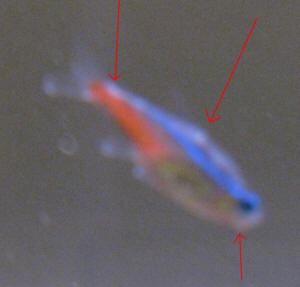
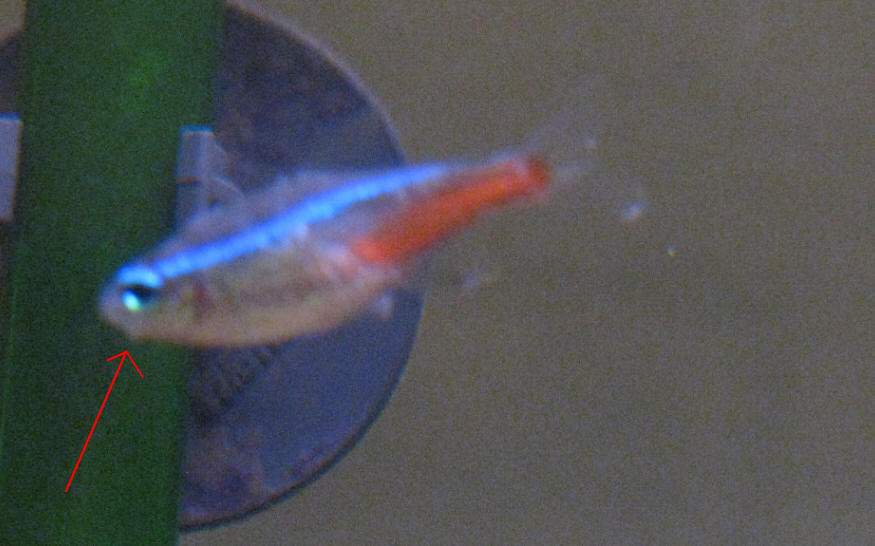
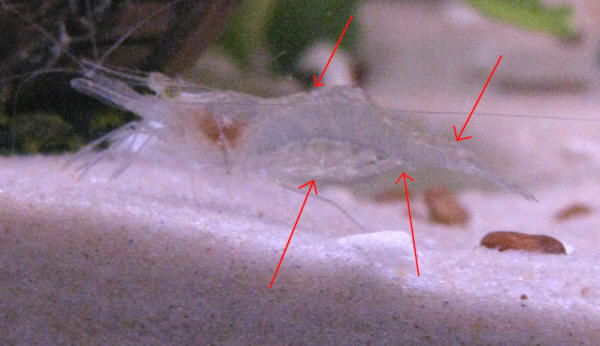 |
|
Lump on cardinal tetra.
4/25/13
Hello WWM crew,
<Fremi>
I need your expert advice with one of my cardinal tetras. It has what
looks like a lump on the area under its gills. I attached two pictures I
hope you can see them.
<No photos attached.>
It started as a white patch a few days ago and now it looks almost
transparent with what it looks like a white worm inside. I have not
tried any medication yet.
<Could be several things. Is the "white worm" moving? How has it
developed in the past 24 hours?>
He is eating ok and schooling with the others. I have 5 other cardinals
and 1 Amano shrimp in the tank which are all looking good. The tank is a
12 gal planted with water parameters of: ph 7.5, kH 6, gH 7, ammonia 0,
nitrite 0, nitrate 5, temp 82. I use RO water buffering with baking soda
to 6 kH and adding some SeaChem flourish for the plants once a week when
I do the 30% water change. I also have a diy co2 system.
I've had the tank set up for about 3 months. I did the fishless cycle
successfully thanks to some great advice from the awesome Bob Fenner.
And added the fishes and shrimp about 2 months ago. No problems so far
except for this issue now. If you know what it is and how to treat it if
there is any treatment for it. Any comments and advice will be
appreciated.
<Without the photos it's dangerous to guess at treatment. It matters a
lot if the "white worm" is a parasite or just something that looks like
a worm but is not. That is to say, is there a parasite involved? What I
will say is that this tetra should be quarantined ASAP to minimize the
chance of spreading it to other inhabitants.>
Thank you Fremi.
<I'm afraid not much help at the moment, but do try to attach the photos
again. The will be very helpful. - Rick>
Re: Lump on cardinal tetra. 4/25/13
Hello Rick,
<Hi Fremi>
I attached two pictures, I hope they come through.
<Yes, and the photos show the lump as clearly as can be expected.>
There has been no change in the past 24 hrs it is still the same. The
worm is not moving it just looks like a s shape white worm almost like a
hair inside a water blister.
<It's very strange indeed. I haven't encountered a problem like
this.
Nothing similar appears in my manual of fish health either, which leaves
us still guessing. My guess is that it is either parasitic or
bacterial similar to a lesion, but of the two I am inclined to think
parasitic. I would definitely quarantine this fish, which helps prevent
spreading to other tankmates. It's also easier to medicate in a small
tank. I've had success against parasites with API General Cure and
also with Prazi-Pro,
but they don't treat exactly the same things. If it were me, I'd
be inclined to give General Cure a try, but let's see if anyone else
recognizes this. Taking blind shots with meds is stressful for the fish.
Bob and/or Neale, have either of you seen this before? - Rick><<I have;
many times... Sporozoan/Microsporidean likely; not treatable... and yes,
catching to conspecifics. Might be of use to have a read here:
http://www.wetwebmedia.com/FWSubWebIndex/cardinaltets.htm
RMF>>
|
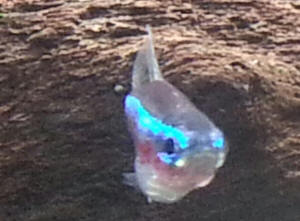
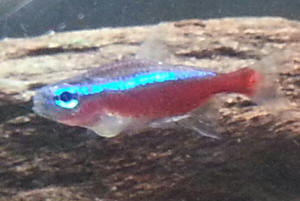 |
|
Re: Lump on cardinal tetra. 4/26/13
<<<<I have; many times... Sporozoan/Microsporidean likely; not treatable...
and yes, catching to conspecifics. Might be of use to have a read here:
http://www.wetwebmedia.com/FWSubWebIndex/cardinaltets.htm
RMF>>>>
<Bob, thanks for the input and link. Fremi, there we are. Please read the
link Bob provided (as I shall), and do quarantine that fish before you have
more of this problem You can still take a stab at treatment but as
indicated, success is doubtful. - Rick>
|
|
|

